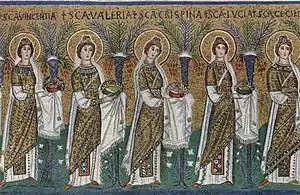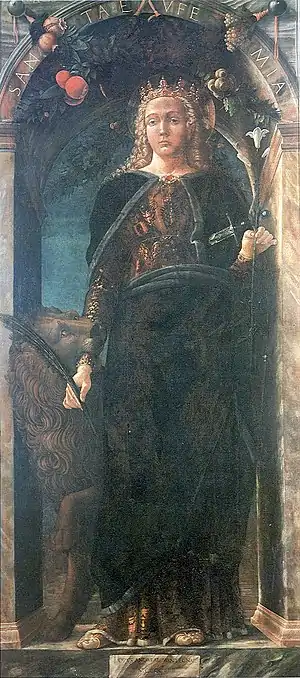Virgin (title)
The title Virgin (Latin Virgo, Greek Παρθένος) is an honorific bestowed on female saints and blesseds in both the Eastern Orthodox Church and the Roman Catholic Church.

Chastity is one of the seven virtues in Christian tradition, listed by Pope Gregory I at the end of the 6th century. In 1 Corinthians, Saint Paul suggests a special role for virgins or unmarried women (ἡ γυνὴ καὶ ἡ παρθένος ἡ ἄγαμος) as more suitable for "the things of the Lord" (μεριμνᾷ τὰ τοῦ κυρίου).[1] In 2 Corinthians 11:2, Paul alludes to the metaphor of the Church as Bride of Christ by addressing the congregation "I have espoused you to one husband, that I may present you as a chaste virgin to Christ".
In the theology of the Church Fathers, the prototype of the sacred virgin is Mary, the mother of Jesus, consecrated by the Holy Spirit at the Annunciation.[2] Although not stated in the gospels, the perpetual virginity of Mary was widely upheld as a dogma by the Church Fathers from the 4th century.
Virgin martyrs

In the hagiography of Christian martyrs of the late 1st to early 4th centuries, virgin martyrs (Latin virgo et martyr, Greek παρθένος-μάρτυρας, Russian дева-мученица) are Christian virgins, often persecuted for their refusal to enter a worldly marriage after having vowed to keep their virginity for the sake of heaven. Diffent martyrologies (for example the Martyrologium Romanum or the Martyrologium Hieronymianum) list early virgin martyrs, some of which are also named in the Canon of the Mass:
- Felicula and Petronilla of Rome (d. c. 90)
- Cecilia of Rome (2nd c.)
- Pudentiana (2nd c.)
- Venera (d. 143)
- Glyceria (d. 177)
- Agatha of Sicily (early 3 c
- Gundenis of Carthage (early 3rd c.)
- Martina of Rome (d. 228)
- Tatiana of Rome (d. 226 or 235)
- Euthalia of Sicily (3rd c.)
- Regina of Autun (c. 231 – c. 251 AD)
- Barbara of Nicomedia (3rd c.)
- Denise of Lampsacus (3rd c.)
- Christina of Bolsena (3rd c.)
- Vibiana (3rd c.)
- Apollonia of Alexandria (d. 249)
- Pelagia of Antioch (late 3rd c.)
- Margaret of Antioch (d. 289)
- Theodosia of Tyre (d. 290)
- Diocletian Persecution (302–311)
- Demiana and the 40 Virgins
- Menodora, Metrodora, and Nymphodora
- Pelagia of Tarsus
- Theodora of Alexandria
- Engratia of Zaragoza (d. 303)
- Euphemia of Chalcedon (d. 303)
- Devota of Corsica (d. 303)
- Agnes of Rome (d. 304)
- Anastasia of Sirmium (d. 304)
- Charitina of Amisus (d. 304)
- Febronia of Nisibis (d. 304)
- Justina of Padua (d. 304)
- Lucia of Syracuse (d. 304)
- Philomena of Rome (d. 304)
- Catherine of Alexandria (d. 305)
- Dorothea of Caesarea (d. 311)
Post-Nicean Virgin martyrs:
- Bibiana (Viviana) of Rome (d. 361/3)
- Ursula and companions, such as Letitia (d. 384; various other traditional dates)
- Quiteria (5th century)
- Julia of Corsica (d. 439)
- Olivia of Palermo (d. 448)
- Juthwara (6th century)
- Nympha of Palermo (6th century)
- Winifred (d. c. 660)
- Belina (d. 1153), canonized in 1203
- Markella of Chios (14th century)
- Joan of Arc (d. 1431), canonized in 1920
- Maria Goretti (1890–1902), canonized in 1950
- Nina Kuznetsova (Нина Кузнецова) martyr of Vologda (1938), canonized in the Russioan Orthodox Church
Consecrated virgins
The tradition of the rite of the Consecratio virginum (consecration of a virgin) dates back to the 4th century, the form of life to apostolic times. The first known formal consecration is that of Saint Marcellina, dated AD 353, mentioned in De Virginibus by her brother, Saint Ambrose. Another early consecrated virgin is Saint Genevieve (c. 422 – c. 512).
Saint Margaret of Hungary (1242–1270) is noted as a nun and virgin, as she was consecrated as a virgin although she already had taken monastic vows; this was done in order to dissuade her father, king Béla IV of Hungary, from trying to have her vows rescinded by the pope for the purposes of a political marriage.
According to Raymond of Capua, Saint Catherine of Siena (c. 1347–1380) at the age of twenty-one (c. 1368) experienced what she described in her letters as a Mystical Marriage with Jesus Christ, later a popular subject in art as the Mystic marriage of Saint Catherine.
Virgins are consecrated for the church as a bride of Christ both in the Orthodox churches and the Roman Catholic church. While in the latter one the consecration has been bestowed for centuries only for nuns living in cloistered monasteries, the bestowal for women living in the world has been reintroduced under Pope Paul VI in 1970.[3] The number of consecrated virgins ranges in the thousands. Estimates derived from the diocesan records range at around 5,000 consecrated virgins worldwide as of 2018.[4]
References
- 1 Corinthians 7:34 "There is difference also between a wife and a virgin. The unmarried woman careth for the things of the Lord, that she may be holy both in body and in spirit: but she that is married careth for the things of the world, how she may please her husband." (KJV).
- "To participants in the International Congress of the Ordo Virginum (May 15, 2008) | BENEDICT XVI". w2.vatican.va. Retrieved 2019-11-17.
- Ordo Consecrationis Virginum (31 May 1970), AAS 62 (1970) 650 = EDIL 2082-2092 = DOL 294 no. 3352. English translation: The Rites of the Catholic Church 2 (n. 29, p. 81), 132-164, DOL 395 nos. 3253-3262.
- Bernadette Mary Reis, "Church reproposes Order of Virgins 50 years after its restoration", Vatican News, 4 July 2018.
- Karen A. Winstead, Chaste Passions: Medieval English Virgin Martyr Legends, Cornell University Press (2000).